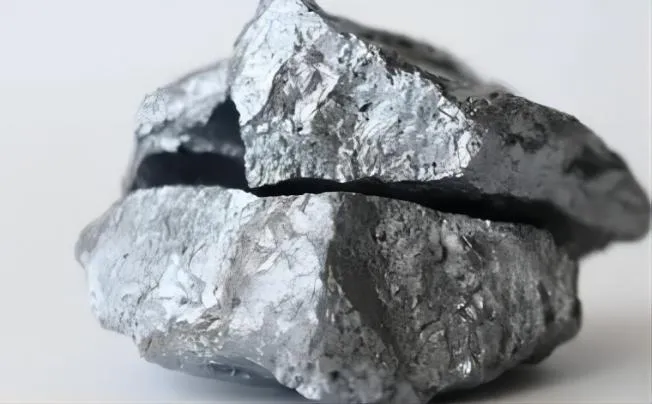Often referred to as crystalline silicon or industrial silicon, silicon metal is a grey, glossy semiconductor metal that is mostly utilized as an additive for non-ferrous alloys that are melted from quartz and coke in an electric furnace.
What is Silicon Metal Grade 441?
Grade 441 silicon metal has a 99% silicon content. Calcium, aluminium, and iron concentrations are 4%, 4%, and 1%, respectively. A crucial component in the production of steel is silicon. There is more silicon in silicon 441. Thus, it can be applied in the steel sector as an additive for iron alloys. Metal silicon 441 costs more than metal silicon 553, but it’s of superior quality.
Metallic silicon is often categorized based on the amount of iron, aluminium, and calcium it contains. Silicon metal is available in a variety of grades, including 553, 441, 411, 3303, 2202, and 1101.
| Silicon metal lump | Content(%) | |||
| Si≥ | Fe≤ | Ai≤ | Ca≤ | |
| 441 | 99.00 | 0.40 | 0.40 | 0.1 |
Characteristics of Silicon Metal 441
The term silicon metal 441 designates a particular grade or kind of silicon metal.
- Chemical Composition: Silicon makes up the majority of silicon metal (441); this silicon often has a purity level of greater than 98%. Additionally, trace levels of contaminants like carbon, calcium, aluminium, and iron may be present.
- Physical Characteristics: Silicon metal has a crystalline structure and is a bright, silver-grey solid. It has a density of around 2.33 grammes per cubic centimetre and a high melting point of about 1,414 degrees Celsius.
- Electrical Properties: Silicon exhibits intermediate electrical conductivity between insulators and conductors (metals) as a semiconductor material. Because of its capacity to carry electricity under specific circumstances, it finds extensive application in the electronics industry.
- Thermal Properties: Silicon metal 441 can transmit heat effectively because of its high thermal conductivity. It also expands and shrinks relatively little with temperature changes due to its low coefficient of thermal expansion.
- Chemical Reactivity: It doesn’t react with most acids or bases and is comparatively innocuous. Under some circumstances, it can react with halogens or some powerful oxidizing agents.
The Content of Silicon Metal 441
The alloy silicon metal 441 is a non-ferrous kind. Typically, we will employ the content of metal elements as a brand to differentiate. For instance, the ferro element content is 0.4, the aluminium content is 0.4, and the calcium content is 0.4. Then, silicon metal 441, which has a higher grade of silicon content and, most importantly, a silicon content proportion of 99%, has a better deoxidation effect during the steelmaking process.
What Are the Uses of Metallic Silicon 441?
- Semiconductor Industry: Silicon is used extensively in the manufacturing of semiconductors, which are vital parts of electronic equipment including integrated circuits, computers, and cell phones.
- Solar Cells: Sunlight is converted into power by the use of silicon metal 441 in solar cell manufacture. It is an essential part of photovoltaic panels, which generate electricity using solar energy.
- Alloys: It is mixed with different alloys to increase their hardness, heat resistance, and strength. For instance, it’s frequently employed in the manufacturing of cast iron and aluminium-silicon alloys for auto components.
- Chemical Industry: A variety of chemicals and compounds are produced using silicon metal 441. It plays a crucial role in the creation of silicones, which are utilized in lubricants, sealants, adhesives, and medical applications.
- Glass and Ceramics: It plays a significant role in the manufacturing of these materials. It gives these materials stability, strength, and heat resistance.
What Is the Difference Between Metal Silicon 441 and 553?
In our nation, metallic silicon is often categorized based on the amounts of its three primary impurities—calcium, aluminium, and iron. Metallic silicon can be classified into several grades, such as 553, 441, 411, 421, 3303, 3305, 2202, 2502, 1501, and 1101, based on the proportion of iron, aluminium, and calcium in it. For example, 553 indicates the content of iron, aluminium, and calcium in metallic silicon, which is 0.5% and 0.5%, respectively; 441 indicates the content of iron, aluminium, and calcium in metallic silicon, which is 0.4%, 0.4%, and 0.1%. In each grade, the first and second codes indicate the percentage content of iron and aluminium, and the third and fourth digits represent the calcium content.
Consequently, the purity difference between 441 and 553 is what separates them. 553 has a silicon content of ≥98.7%, whereas 441 has a silicon content of ≥99.1%. In particular, quartz and carbon react at a high temperature in a submerged furnace to produce industrial silicon: SIO2 + C= SI + CO2. As with the grade of quartz, the quality of carbon used as a reducing agent can likewise vary widely. The purity of industrial silicon is determined by the variations in these basic ingredients. From a financial standpoint, higher-quality raw materials will cost more.
Zhenan-Our Advantages
- Extensive ferroalloy production facility with over 30 years of expertise.
- Direct sales from the factory, no middleman.
- Give retailers exclusive discounts and local protection.
- Provide the SGS/CCIC inspection report and ISO certification.
- The size and packaging can be customized.
- 24-hour online customer support as well as technical support from abroad.








